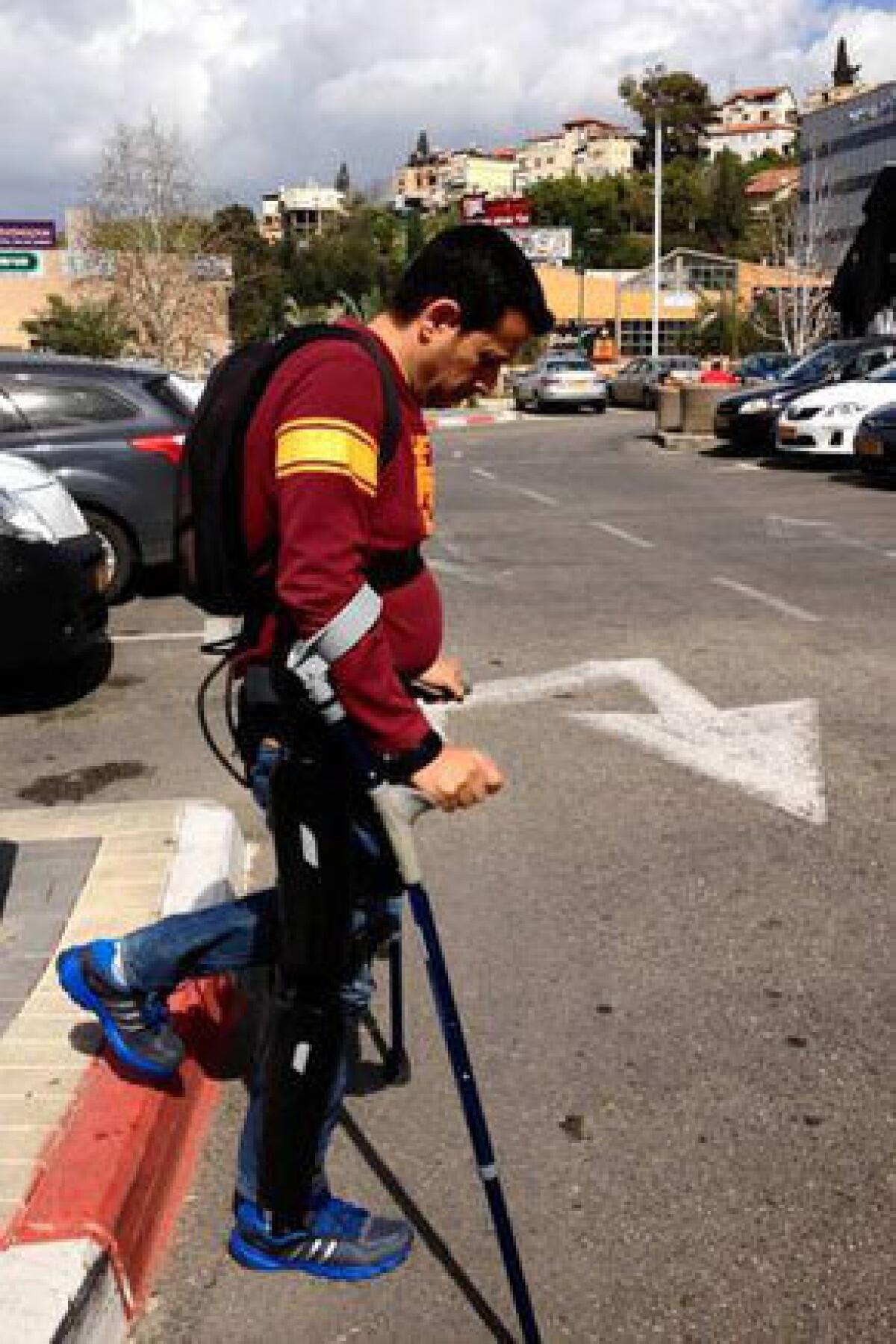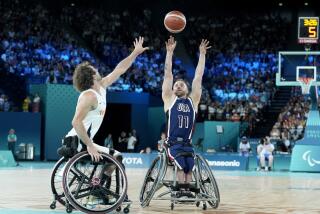Paraplegic will leave wheelchair behind for Tel Aviv marathon

- Share via
YOKNEAM ILLIT, Israel — The bullet that tore through Israeli paratrooper Radi Kaiuf’s spine during a 1988 Lebanon firefight shattered his dreams of becoming a dentist. Doctors said he’d never again walk or have a normal life.
But Kaiuf, now 46, had other ideas. He decided he would not allow the injury to defeat or define him.
Over the years he married and had four children. He learned to drive with a specially equipped car, exercised with a hand-powered bicycle and even went skiing in a wheelchair.
On Friday, Kaiuf, a Druze Arab born in the village of Osfiye, will take another big step — actually about 15,000 of them.
Using a groundbreaking Israeli medical device that enables those paralyzed from the waist down to walk with the aid of robotic leg braces, Kaiuf hopes to become the first paraplegic to finish a competitive race in real time without a wheelchair.
He will compete in the 10-kilometer (6.2-mile) race associated with the Tel Aviv marathon, a challenge that will probably take five hours and require at least one battery change for the 55-pound exoskeleton machine. On Tuesday, the full marathon was rescheduled for March 22 because of an expected heat wave, but the shorter race will go on as planned.
Though a British woman last year used the same bionic device to complete the entire London marathon over a 16-day period, Friday’s race will mark the longest attempt yet of continual use of the invention, called ReWalk.
“Accepting my handicap was not easy,” he said. “I still haven’t accepted it to this day. That’s probably why I am always doing crazy things. It’s my way of rejecting the disability.”
One of the first people to test ReWalk, Kaiuf is now employed full time as a professional guinea pig of sorts by maker Argo Medical Technologies, a startup funded by Israel’s Technion technical institute and private investors. He tests the device for comfort, ease of use and endurance.
Available in Europe since autumn for about $68,000, the machine is not sold yet for personal use in the United States, pending Food and Drug Administration approval, which the company hopes to receive this year, said Argo general manager Oren Tamari.
More than 100 ReWalk devices are being tested in hospitals in Europe and the U.S., including Downey’s Rancho Los Amigos National Rehabilitation Center. The ReWalk was featured in a 2010 episode of “Glee,” in which a partially paralyzed character uses it to walk.
The idea for the device came to Israeli computer scientist Amit Goffer after he became a quadriplegic in a 1997 car accident. He can’t use the device because it currently is suitable only for lower-body paralysis, but he’s working on a model for himself.
Goffer and Kaiuf met at a rehabilitation hospital, and the inventor — impressed by Kaiuf’s energy and adventurism — asked the ex-soldier to try it.
At first Kaiuf needed extensive training to learn how to walk, balance himself, navigate stairs, sit down and stand up again.
Seven years later, he’s such an expert that he’s pushing designers to make the product faster or sturdy enough to walk on a sandy beach. He’s traveled around the world as a company spokesman.
During a recent walk to a shopping mall, Kaiuf drew some stares and glances.
While in the device, his legs are strapped to braces and his feet rest on platforms inside the soles of his tennis shoes. A backpack holds the battery and a wireless wristwatch enables him to enter commands to sit, stand or step up. Crutches help him keep his balance.
There’s a robotic whirring noise as the device moves, leading to predictable jokes about RoboCop or Iron Man. But Kaiuf looks more like someone with badly broken legs.
Though he still uses the wheelchair for some activities, ReWalk reopened a world of simple pleasures, he said, such as navigating the narrow passages of Acre’s ancient city market or reaching top kitchen shelves to make his children a snack.
Accustomed to a father whose seated height was about 4 feet, it was an adjustment for his children to see him standing about 5 foot 9.
But the ability to face the world at eye level again is one of the biggest advantages, he said. In a wheelchair, he often encounters pity and condescension. When he uses a wheelchair in a restaurant, for example, waiters sometimes ask his companion for Kaiuf’s food order, as if he were a child.
“There’s a stigma about being in a wheelchair, as if your mental capacities are affected as well,” he said. “Being upright makes a big difference. People regard me as normal.”
The ultimate dream for the former paratrooper is to jump out of an airplane again with the device, an idea that causes company officials to laugh nervously.
When he told his doctors about his plans for the race, they advised against it, saying the physical exertion would be too great. Kaiuf smiled and continued his training.
“It’s another way to test my limits,” he said. “It’s like jumping out of an airplane. Once you jump, there’s no turning back.”
More to Read
Sign up for Essential California
The most important California stories and recommendations in your inbox every morning.
You may occasionally receive promotional content from the Los Angeles Times.










